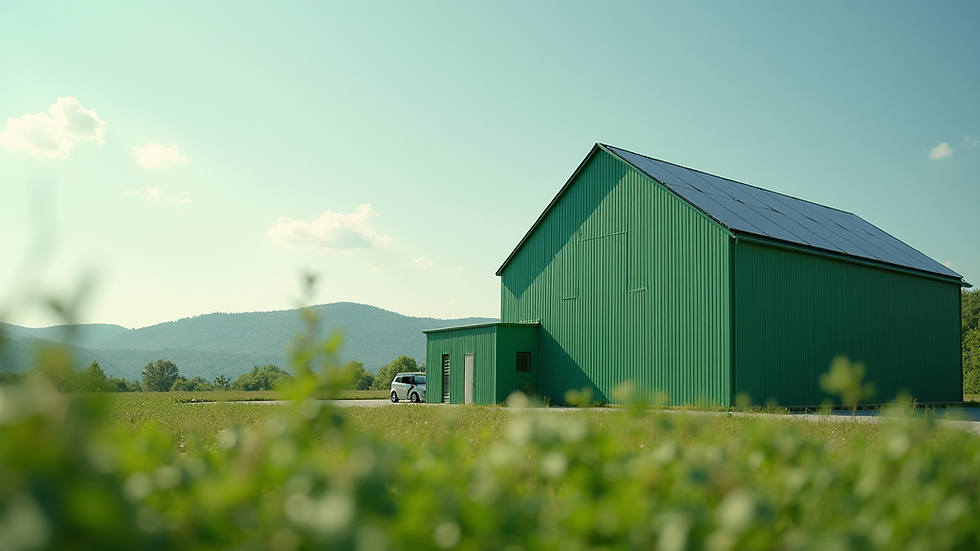Innovative Approaches to Modern Architectural Design
- Adam M

- Jul 19
- 4 min read
The world of architecture is constantly evolving, driven by new technologies, environmental concerns, and shifting cultural values. Modern architectural trends reflect these changes. As architects explore innovative approaches, they create structures that are not only functional but also resonate with the environment and human experience. This blog post delves into these modern trends and highlights significant innovations reshaping architectural design.
Modern Architectural Trends
One of the most significant trends today is sustainability. Architects are increasingly focusing on eco-friendly building materials, energy-efficient designs, and practices that reduce the carbon footprint. For instance, using reclaimed wood and recycled materials has become quite popular. According to the U.S. Green Building Council, green building practices can reduce energy consumption by up to 30 percent, leading to considerable cost savings over time.

In addition to sustainability, another trend is the integration of smart technology into architectural design. Smart homes are equipped with systems that enhance comfort, security, and energy efficiency. Smart thermostats, automated lighting, and integrated security features are becoming standard in modern homes. A report by Markets and Markets predicts that the smart home market will reach $174 billion by 2025, profoundly influencing architectural design.

Furthermore, community-centric designs are gaining traction. Architects are now creating spaces that foster community engagement and social interaction. For example, mixed-use developments blend residential, commercial, and recreational spaces to promote a sense of community. According to a study by the Urban Land Institute, mixed-use developments can lead to a 20% increase in foot traffic, enhancing local businesses and community life.
What is the Role of Architectural Design?
The role of architectural design extends beyond mere aesthetics; it impacts functionality, safety, and sustainability. Architectural design dictates how buildings interact with their surroundings, guiding water flow, managing sunlight, and influencing airflow. Effective design can optimize energy use and minimize waste, contributing to the overall health of our planet.
Moreover, architectural design resonates with people on an emotional level. Spaces designed with careful consideration to human experience provide comfort and promote well-being. Biophilic design, which incorporates natural elements into building spaces, has been shown to reduce stress and improve cognitive function. Research from Harvard University indicates that incorporating natural light and greenery can increase worker productivity by up to 15%.

Emerging Materials in Modern Architecture
Innovative materials play a pivotal role in modern architectural design. Cross-laminated timber (CLT) is gaining popularity due to its strength, lightweight nature, and sustainability. Buildings constructed with CLT can be completed faster and often have a lower environmental impact than traditional concrete or steel structures.
Additionally, 3D printing technology is revolutionizing the construction industry. Architects can create complex designs quickly and at a reduced cost. The first 3D-printed house was completed in 2018, demonstrating that this technology can produce sustainable, affordable housing. By using 3D printing, architects are able to push the boundaries of design further than ever before.
The Rise of Modular and Prefabricated Construction
One of the most efficient approaches to modern architectural design is modular and prefabricated construction. These methods involve creating building modules off-site and transporting them to the construction site, reducing construction time significantly.
A notable example of modular construction is the Aditi House, which can be assembled in just a few days. Its design not only minimizes waste but also provides an affordable solution to housing shortages. Moreover, the precision of modular construction ensures higher quality and sustainability throughout the building process.
Moreover, modular construction is versatile. It can adapt to various architectures, whether for single-family homes or larger commercial buildings. By reducing the time it takes to build, it also lowers labor costs and minimizes disruption to the surrounding area.
Architectural Design for Resilience
Another critical focus in modern architectural design is resilience against climate change and natural disasters. Architects are now prioritizing designs that can withstand extreme weather conditions. Elevated structures, for example, are often used in flood-prone areas, while innovative materials help buildings withstand earthquakes.
The use of climate-responsive design is gaining attention. For example, buildings in hot climates often feature thick walls, reflective roofs, and shaded areas to minimize heat. In colder regions, designs incorporate large windows for passive solar heating, while also providing insulation.
These innovations ensure that architectural designs not only meet current needs but are also equipped to adapt to future challenges. Architects must consider long-term impacts on the environment and communities when conceptualizing their designs.

Looking to the Future of Architectural Design
As we move towards a more interconnected world, the future of architectural design looks promising. Innovations in technology, materials, and sustainability are reshaping how we build. The focus on human experience and environmental consciousness will continue to influence architectural principles.
Architects must embrace these changes, adapting their designs to meet the needs of future generations. Collaboration between architects, engineers, and technology experts will play a crucial role in creating innovative solutions. Virtual reality, augmented reality, and artificial intelligence will likely become standard tools in the design and construction process.
In summary, the field of architectural design is a dynamic blend of creativity, technology, and environmental responsibility. By embracing innovative approaches, architects can create spaces that inspire, engage communities, and respect our planet. The evolution of architectural design will continue to be a fascinating journey as we push toward a sustainable and resilient future.



